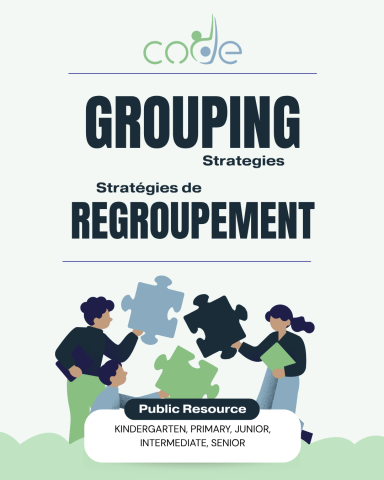
Overview / Aperçu

Strategies featured here have been used by drama and dance practitioners, educators, and artists in various formats for many years. If we have sourced a game from a specific website, it is credited at the end of the game description.
Most of these strategies can be adapted up or down with the right supports (e.g., increasing complexity of instructions for older students). Most of these strategies result in a random generation of groups which may not be suitable for all student needs; use your professional judgment about whether these strategies are right for your group or if you need to include accommodations or constraints to support the success of some students.
Notes:
- It may be worthwhile to review procedures for participating safely in drama games before playing (e.g., be prepared to stop when the teacher needs your attention, etc.). Explicit rehearsal of procedures and routines are beneficial for all students and essential for some.
- Games should include the right to pass and the right to return when students are ready and able to participate again. This honours the social and emotional access needs of students including the need for longer transitions and opportunities to observe before participating, and physical access needs including the need for rest if an activity is overstimulating or tiring. It also honours preferences if a game includes touch that does not feel safe or appropriate for a student (for any reason).
-
When working in groups, many students require support regulating their emotions, using direct communication to engage in productive conflict, actively listening to another perspective in a conflict, and managing group roles. Consider explicit teaching of strategies like:
- "I feel [emotion] when you [behaviour] because [explanation]." "I hear that you're feeling [emotion] when I [behaviour] because [explanation]. The thing is [clarification]."
- "The story I'm telling myself is [assumption]. Is that true?"
- Making a Justice Oriented Apology
Category
Strategies
When to Use
- Atom
- Linear Continuum
- Number Off
- We Go Together
To form instant randomized groups for short-term work together.
No preparation of materials required.
- Coloured Sticks
- What's Your Number?
- Partner Map
- Magic Hat
- Musical Groups
- Random Group Generator
- Back to Basics
To establish a consistent system for establishing randomized groups.
Preparation of materials may be required.
- We Go Together
- Partner Map
- Compounding Groups
To form groups for partner work, or to divide the class into two large groups.
- Cacophony / Barn Yard
- We Go Together
- Compounding Groups
To form groups for small group work, or to divide the class into a certain number of groups.
- We Go Together
- Partner Map
- Compounding Groups
- Text Fragments
- Category Is
To include a quick, informal review of a classroom concept that involves categories or specific vocabulary while forming groups.
- Choice Board
- Mantle of the Expert
- Topic of Interest
- Social Preferences
To engage students in a task through choice.
The groups do not need to be random.
